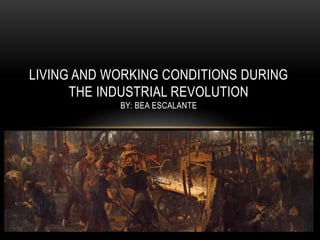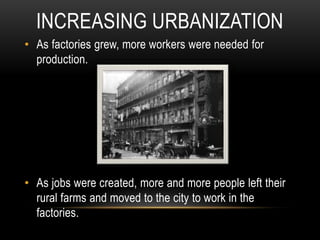theindustrialrevolution1-150317153903-conversion-gate01.pdf
- 1. LIVING AND WORKING CONDITIONS DURING THE INDUSTRIAL REVOLUTION BY: BEA ESCALANTE
- 2. THE INDUSTRIAL REVOLUTION ŌĆó The Industrial Revolution began in the 18th century and lasted until the mid 19th century. ŌĆó Before this time, every product was made by hand.
- 3. BEFORE THE INDUSTRIAL REVOLUTION ŌĆó At this time, people produced their own food, clothes, tools, etcŌĆ” Production was very inefficient ŌĆó The working man was lucky to own two shirts.
- 4. 1760 ŌĆó The Industrial Revolution began in the year 1760 when the textile industry was transformed by the invention of machines. ŌĆó Production became efficient and cost-effective.
- 5. DURING THE INDUSTRIAL REVOLUTION ŌĆó A lot more than just the textile industry changed. For example, agriculture, transportation, and manufacturing in general were transformed.
- 6. INCREASING URBANIZATION ŌĆó As factories grew, more workers were needed for production. ŌĆó As jobs were created, more and more people left their rural farms and moved to the city to work in the factories.
- 7. WORKERS ŌĆó Since the work was abundant, these factories employed men, women and children of all ages.
- 8. WORKING CONDITIONS ŌĆó Workers were expected to work 16 to 18 hours a day, seven days a week. ŌĆó Wages were very low: less than a pound for men, 10 shillings for women, and 3 shillings for children. ŌĆó This is equivalent to: 320 Euros per year, or 0,08 cents per day.
- 9. WORKING CONDITIONS ŌĆó On any given day, there could be more than 500 workers in a factory so the environment was hot, noisy, full of steam, fumes and dust. ŌĆó Sanitary conditions were also terrible. There was no clean water and toilets were often a hole in the ground. ŌĆó Work-related accidents were common and the workers received no compensation. ŌĆó Triangle Shirt Factory fire killed 114 workers.
- 10. CHILD LABOR ŌĆó During the Industrial Revolution children constituted 2/3 of the working force in England and Scotland. ŌĆó They were expected to work as long as adults ŌĆó They were paid significantly less than adults ŌĆó They performed dangerous jobs such as climbing the machines to unblock them or going into narrow spaces to collect coal. CHEAP LABOR
- 11. CHILD LABOR ŌĆó Children worked in extremely unsanitary conditions ŌĆó They were often beaten by other workers.
- 12. FACTORY ACT ŌĆó Although the factories claimed that they were providing jobs for the poor, eventually the government intervened and passed the Factory Act in 1844. ŌĆó This law established that children had to be 9 years or older to work and they could only work 12 hours a day.
- 13. LIVING CONDITIONS FOR WORKERS ŌĆó As a result from the fumes and dust that workers often inhaled for many hours a day, chest illnesses were common. ŌĆó Houses and apartments were not properly conditioned to be lived in and they were also very expensive.
- 14. LIVING CONDITIONS FOR WORKERS ŌĆó There was no proper sewage systems in either the working places or the living spaces so diseases like cholera, typhoid, and tuberculosis rapidly spread. ŌĆó During the 19th century, 10.000 people died from cholera and 60.000 died from tuberculosis. ŌĆó The life expectancy dropped drastically ŌĆó In London people were expected to live only 37 years. ŌĆó Twenty five percent of children died before they were five years old.
- 15. TODAY ŌĆó The International Labor Organization estimates that 215 million children between the ages of 5 and 17 are working under conditions that are considered illegal, hazardous, or extremely exploitative.
- 16. DEVELOPING COUNTRIES ŌĆó Of the estimated 215 child laborers around the globe: approximately 114 million (53%) are in Asia and the Pacific; 14 million (7%) live in Latin America; and 65 million (30%) live in sub-Saharan Africa. ŌĆó Agriculture, manufacturing, mining, domestic service, etc.
- 17. WHAT CAUSES CHILD LABOR? ŌĆó Poverty ŌĆó Free education is limited ŌĆó Existing laws are violated
- 18. HEALTH AND DEVELOPMENTAL RISK FACTORS ŌĆó Greater risk of hearing loss ŌĆó Smaller size ŌĆó Development of organs and tissues ŌĆó Lower heat tolerance ŌĆó Higher chemical absorption rates
- 19. Think about the Industrial Revolution and the world todayŌĆ”. Why do we still have child labor?



















